|
|
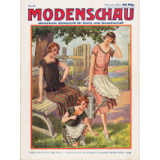
|
Front page, title page or cover of the German fashion magazine Modenschau (Eng. title: Fashion Show, subtitle: Illustrated Monthly Magazine for Home and Society) no. 149 from May 1925.
Description of the colored front cover picture.
J 9134. Dirndl dress made of smooth and striped poplin. The fabric of the skirt forms the trim at the waist. Pattern size 44 (Large pattern).
J 9135. Dirndl dress for girls aged 6—8 and 8—10. It is made of wash fabric. The smooth waist lies on the plaid skirt. Velvet ribbon at the edges. White batiste apron. (Small pattern)
J 9136. Dirndl dress made of plaid calico with black velvet trim. White batiste apron. Pattern size 44 (Large pattern).
Price per issue: 60 pfennigs plus delivery charge.
Publishing house GUSTAV LYON, Berlin SO 16 — Distribution for the book trade in Germany WILHELM OPETZ, Leipzig.
Title illustration/title drawing: unknown/unsigned.
|
|
|
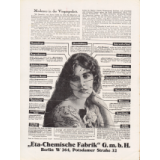
|
Article:
N. N., Modernity in the Past.
[N. N., Modernity in the Past.]
We people of today love to smile pityingly at the people of a hundred or even a thousand years ago because of their technically imperfect way of life. So it's quite entertaining to list phenomena of modern life that existed centuries or even millennia ago.
Advertising pillars for amusement advertisements already existed in ancient Herculanum. These columns were also used for advertising purposes. And what was used to stick these posters on? With the same gum arabic that we still use today!
Rails were also known in antiquity. They were made by digging cuts into the stony ground in the width of the most common wheel track. Such tracks existed at the gates of Athens and were laid out by the ancient Romans, many of which have been found in France.
In 1300 BC, the ancient Egyptians already had the lightning arrester. Their city gates carried gilded spikes on high poles, and according to Livy (at the beginning of our era) reports that Greek and Roman priests had already mastered the art of bringing down lightning from the sky. They had observed that certain metals had the property of attracting lightning, and even in those days many a person who engaged in this dangerous game of catch, such as Franklin later, was struck dead by lightning. Livy and his colleagues do not report on the connection of the gold-plated lightning rods to the ground, so that we must assume that these probably most important components of the lightning conductor had not yet been invented at that time.
The profession of source finder is also not new. In ancient times there were already guild-like associations of this profession. Among other things, they supplied members of the guild to the armies in order to procure drinking water immediately by drilling wells when needed. For example, Roman well diggers in the North African desert had great success by drilling wells in over 200 places, thus enabling the army to carry out its planned campaigns. It is not said whether these well seekers were already using divining rods.
Advertising:
(Hair care) Dandruff, even if tiny, encrusts the scalp, suffocates the hair shaft and the hair falls out. Eliminate dandruff and dandruff with "Eta-Haarkur" ["Eta Hair Treatment"]. "Eta Hair Treatment" promotes growth and a magnificent, full head of hair develops… Price with prescription marks 2.50.
(Eyebrows) become thicker and stronger with "Eta-Augenbrauenbalsam" ["Eta Eyebrow Balm"]. Gradually darkens at the same time. (Unwashable.) The face becomes expressive and interesting… Price with distributor marks 2.—.
(Beautiful eyes.) "Eta-Augenbad" ["Eta Eye Bath"] strengthens the eye nerves; dull eyes become radiantly fresh and shiny, become larger; the gaze becomes attractive and captivating. Price with anatomical "Eye Bath Tub"… marks 2.50.
(Annoying hairs.) "Eta-Haarzerstoerer" ["Eta Hair Destroyer"] bleaches and decomposes the hairs so that they become completely colorless and thin and are not visible like downy hairs. Price complete marks 5.—.
(Snow-white teeth.) "Eta-Mass" dissolves all yellow deposits and tartar instantly. Cleaned white teeth are what give that strong attractive appeal. Price marks 2.—.
"Eta-Mundblaettchen" ["Eta Mouthwash Lamina"] immediately eliminates bad breath. Price… marks 2.—.
(Excessive fat deposits) on the chin, neck, abdomen, hips, calves and ankles removed by the effective "Eta-Zehrwachs" ["Eta Slimming Wax"] (local embrocation) … price marks 4.—.
(Sunburnt complexion.) "Eta-Sonnenbraun" ["Eta Sun Tan"] gives an interesting, sunburnt complexion… Price marks 2.—.
(Annoying perspiration.) Anyone suffering from annoying foot, hand or underarm perspiration can now get rid of it with a single treatment using the "Eta-Fussbadloesung" ["Eta Foot Bath Solution"]. Feet and armpits are immediately guaranteed to remain dry and completely odorless. (Atrophy of the sweat glands.) — Highly recommended by doctors. Price with distributor and accessories… marks 2.50.
(Hair coloring.) "Eta-Haarfaerbelotion" ["Eta Hair Dying Lotion"] gradually colors each hair brown, dark blond or black. Gives the desired hair tone in 6—14 days… Price complete marks 2.50.
(Pure white complexion.) The "Eta-Maske" ["Eta Mask"], which can be applied at night, thoroughly removes freckles, skin impurities, yellow skin and produces that enviable pure white complexion through the action of oxygen… Price marks 4.—.
Stirnrunzelglaetter [Forehead Wrinkle Smoother], D. R. P. [German Reich Patent] removes forehead wrinkles… marks 4.—.
(Birthmark.) "Eta-Tropfen" ["Eta Drops"] completely remove all tattoos, birthmarks, moles and warts in 8 days. No remedy can match the effect of "Eta Drops"… Price marks 3.50.
(Attractive curls.) A beautiful curl on the cheek makes every face attractive and interesting. "Eta-Haarkraeuseigeist" ["Eta Hair Curling Spirit"] makes natural curls and keeps the hair in loose fullness, even with perspiration… Price marks 2.—.
(Nose shaper and nose redness.) "Eta-Nasenbad" ["Eta Nose Bath"] makes the nose redness disappear completely. No matter whether due to cold, dilated pores or blood. "Eta Nose Bath" has an astringent effect on the blood cells… Price with all accessories marks 5.—.
Nasenformer [Nose shaper] "Zello-Punkt". D. R. P. [German Reich Patent] Price marks 6.—, 8.— and 10.—.
(Skin peeling cure.) The improved new "Eta-Schaelkur" ["Eta Peeling Cure"] according to medical prescription peels off impure gray or yellow skin imperceptibly for the environment in a few days. The new skin appears in the most delicate purity and arouses admiration on all sides… marks 6.—.
(Blackheads.) "Eta-Mitesserentferner" ["Eta Blackhead Remover"] (D. R. G. M.), with which blackheads, pimples and oily skin are easily and immediately removed. Price with accessories… marks 2.50.
Lippenformer [Lip Shaper] … marks 3.—.
(Red hands.) Prepared "Eta-Handhuellen" ["Eta Hand Covers"] with the oxygen bleaching process. This makes the hands soft and strikingly white. Price one pair… marks 4.—.
Fingerspitzenformer [Fingertip Formers] … 5 pieces marks 5.—.
(Beautiful shapes.) "Eta-Formenprickler" ["Eta Shape Prickler"]. A new medical invention! Effect: a deep, pleasant tingling sensation, intensively strengthens and firms the breast tissue cells through newly stimulated blood circulation. The undeveloped or wilted breast becomes lush and plump. The success is medically confirmed. For example, the cosmetician Dr. med. Klatt writes: "Send 2 more Eta Shape Prickler. I have achieved very good results using this device." Price complete marks 6.— with guarantee certificate.
"Eta articles" are patent-protected in accordance with the law of May 12, 1894. Tried by numerous doctors and chemists and brilliantly reviewed. Letters of thanks received daily, even from the most distant countries in the world.
Dispatch unobtrusively by cash on delivery or against advance payment to postal check account Berlin 43634. 40 pfennigs postage extra.
When ordering three different items or more. Items or more free of postage and charges.
"Eta-Chemische Fabrik" ["Eta chemical factory"] G. m. b. H., Berlin W 264, Potsdamer Strasse 32. Drawing/illustration: unknown/unsigned.
|
|
P. 1 |

|
Title page or cover of the German illustrated women's and fashion magazine Modenschau (subtitle: Magazine for Home and Society) no. 149 from May 1925.
Published by Gustav Lyon Berlin SO 16. Founded 1865.
Published monthly. 60 pfennigs.
Issue no. 149. Volume 1925.
Article:
Jung, Hans, The Bridegroom on Trial. Humoresque (by Hans Jung, unknown author). Illustrated by Siggel.
At the center of the story is a drawing showing a middle-aged to elderly gentleman sitting on a low armchair. A cast-iron stove can be seen in the background. The caption reads "and there was no more view…". Drawing/illustration: "Siggel" (unknown artist).
[Page] 1
|
|
P. 2 |
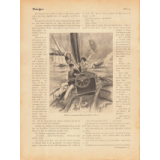
|
Article:
Jung, Hans, The Bridegroom on Trial. Humoresque (by Hans Jung, unknown author). Illustrated by Siggel.
At the center of the story is a drawing showing a woman and a younger man at an oar on the deck of a sailboat on the open sea. There are two other sailing boats in the background. The caption reads "What a heavenly journey through the blue sea!" Drawing/illustration: "Siggel" (unknown artist).
Modenschau, issue no. 149.
[Page] 2
|
|
P. 3 |
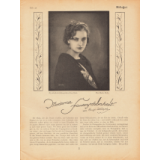
|
Article:
Ulitzsch, Ernst, Modern Women's Beauty (by Ernst Ulitzsch, biographical data unknown).
The large-format photograph above shows a modern female beauty. The caption reads "The Swedish actress Grete [sic] Garbo" (Swedish-US-American film actress Greta Garbo, 1905-1990).
Photo: Binder, Berlin (photo studio Alexander Binder, Berlin, 1888-1929).
[Ulitzsch, Ernst, Modern Women's Beauty.]
The man who told women that beauty is a virtue understood them deeply, because being beautiful or wanting to be beautiful is one of those desires that were no different in ancient times than they are in our very gray days. We like to listen to the stories that tell of beautiful women of the past; but for a long time the realization has prevailed that the beauty that a pleasure-loving humanity can admire in museums often owes its merits to gallant painters. For a man always depicts a woman as she appears to him. The many thousands of female nudes known to art history are contrasted by only very few male nudes, and these are almost always the work of sculptors, a legacy of antiquity. Everywhere the man wanted the beautiful woman — and therefore every woman wanted to be beautiful, if not otherwise, then in the picture.
Ever since photography pushed back portraiture and restricted it to the circles of the very richest, flattery was seemingly impossible, because photography, it was said, tells the truth. In the early days, certainly; but since the photographic technique has been more accurately recognized, this view is no longer true. With a modern photographer, women are more beautiful than they were an age ago, not only because it has been discovered that the black plate does not speak the truth, that it records, but also because it has been discovered how to correct the errors. … [Continued on next page 4].
Issue no. 149, Modenschau.
[Page] 3
|
|
P. 4 |
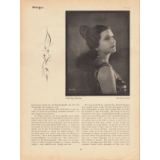
|
Article:
Ulitzsch, Ernst, Modern Women's Beauty (by Ernst Ulitzsch, biographical data unknown).
The large-format photograph above shows a modern female beauty. The caption reads "Countess Agnes Esterhazy" (Austrian actress Agnes Esterházy, 1891-1956).
Photo: Binder, Berlin (photo studio Alexander Binder, Berlin, 1888-1929).
[Ulitzsch, Ernst, Modern Women's Beauty.]
[Continued from previous page 3] … The greatest change was brought about by cinematography, which created a new science of beauty.
Film has reinforced the world's desire to be beautiful. It is based on the effect of triggering beauty — especially female beauty.
The rascal Casanova, who really ought to know, once answered the question of beauty as follows: to wear beautiful clothes is to be beautiful. Of course, he lived in the Rococo period and was only familiar with a very attractive fashion which, however, assigned the human body a secondary role. At that time, the costume and the art of the hairdresser were of primary importance, which is why in all rococo paintings the garments are made as charming as possible with love and artistic understanding. If you want to be considered pretty, you must first and foremost have a pretty face. Other minor body flaws can be concealed, but facial irregularities never can. We owe this experience to cinematography. For if a face appears huge on the screen, no deception is possible — or perhaps it is? For sure, here too!
We have certainly all encountered the lovely Mary Pickford, whose appearance has always made the heart happy and who, without being an actress, has been applauded by audiences all over the world in every role. Her advantage is the childlike purity of her features; the girlish slenderness of her limbs is combined with a facial expression that makes a certainly pretty face desirable. And who was not very disappointed to see the celebrated woman up close? For Mary appeared to be a tiny woman in her mid-thirties, with big cheeks that didn't seem to fit her scrawny body at all; even a slight down on her upper lip could not be overlooked. In any case, she appeared completely different from the screen; and the pretty moviegoers who had sighed that evening at the fame of this little woman would have been outraged if they had been asked to swap places with the real Mary Pickford. So the movie, too, "lies" in the sense that all things in this world lie. On the other hand, really beautiful people often appear insignificant in films, just as photographers are often afraid of beautiful faces because they don't photograph themselves well. … [Continued on next page 5].
Modenschau, issue no. 149.
[Page] 4
|
|
P. 5 |
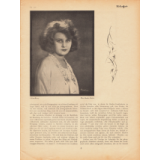
|
Article:
Ulitzsch, Ernst, Modern Women's Beauty (by Ernst Ulitzsch, biographical data unknown).
The large-format photograph above shows a modern female beauty. The caption reads "Lilian Hawey [sic]" (British-German film actress Lilian Harvey, 1906-1968).
Photo: Binder, Berlin (photo studio Alexander Binder, Berlin, 1888-1929).
[Ulitzsch, Ernst, Modern Women's Beauty.]
[Continued from previous page 4] … This is precisely because natural and photographic beauty are two different things that often coincide, but even more often cannot be united.
Natural beauty depends on the animation, the soulfulness of the face. This is why we rarely find faces beautiful that are perfectly regular and whose individual parts are perfectly coordinated, but which betray no movement whatsoever, but remain rigid. A coldness emanates from these faces, which communicates itself to the surroundings and has a repulsive effect. The general view that people with such facial features are gruesome is outdated and comes from the Romanticists' treasure trove of props. Today we believe that such people are limited and seem to see more correctly than our ancestors, who liked to embellish everyday life with events. We no longer love those pale-cheeked people who were so much talked about in the novels of 100 years ago, in which a pale complexion was regarded as a sign of particularly noble descent, a bad habit that Wilhelm Hauff mocked not unkindly in the Signor Bleichwangioso [Mr. Pale-cheeked] of his "Man in the Moon". Today, being beautiful means being healthy, means wearing natural colors on your face. But photography and film want nothing to do with this. Both are extremely sensitive to differences in color and, with the appropriate magnification, show imperfections that the eye can overlook without noticing. All film actors are made up — the face is usually covered with an evenly distributed yellow make-up, which gives a wonderful white complexion, a film complexion. Film and photographic plates reinterpret the colors, which is why Chinese and Japanese, who we believe must appear dark in film, appear bright white. Moreover, only the white race has to wear make-up for the movies! Since the advantages of make-up for photography have been recognized, society ladies often have themselves properly made up before they entrust their faces to the merciless lens of the photographic apparatus. … [Continued on next page 6].
Issue no. 149, Modenschau.
[Page] 5
|
|
P. 6 |
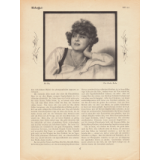
|
Article:
Ulitzsch, Ernst, Modern Women's Beauty (by Ernst Ulitzsch, biographical data unknown).
The large-format photograph above shows a modern female beauty. The caption reads "Mia May" (Austrian silent film actress Mia May, 1884-1980).
Photo: Binder, Berlin (photo studio Alexander Binder, Berlin, 1888-1929).
[Ulitzsch, Ernst, Modern Women's Beauty.]
[Continued from previous page 5] … But make-up alone does not make a film star beautiful. Above all, it requires the strictest regularity of facial features. In life, a face can be beautiful if it has a small flaw; indeed, it is not uncommon for this small flaw to emphasize the charm of the face. Now, all kinds of mistakes can be corrected in films, but irregularities usually preclude a successful film career. A very popular German film actress has a scar on her chin, which is just as distracting in life as the scar on the forehead of a film celebrity or the wart on her cheek, which unfortunately adorns a third person. These three, to give just a few examples, simply make up these flaws away. The yellow make-up allows the studio light to be reflected on a shadowless surface, and a flawless face appears in the film. The broad facial surface is advantageous for good photography, which is why Slavic women such as Elisabeth Pinajeff, Natalie Kowanko and Pola Negri in particular appear so favorably in the film. This is also why Mary Pickford's cheeks, which are not to everyone's taste in daylight, have an indescribable charm as soon as make-up and mercury light turn them into a shadowless surface.
With the great names of film, Mia May, Marcella Albani, the Countess Agnes Esterhazy, Lilian Harvay [sic], who is on the rise, a perfect beauty, which in these cases means not only a film beauty, but also a daylight beauty, if the word is allowed, is self-evident. But how few people know what beauty actually means and how rarely one encounters it. Apart from the film people, of whom, strangely enough, none have yet discovered beauty, the directors of the great revue stages know this. And from their boards, as once from the ballet, the great beauties have leapt into art and life. In Europe, too, the reputation of the Ziegfeld-Follies as the cradle of American female beauty has spread beyond professional circles. The Viennese Ziegfeld has to rebuild his army of women every year, because the beautiful girls are simply married off from him, despite high penalties and long contracts. The most beautiful American movie stars were once Ziegfeld girls — and the German film industry hopes that Hermann Haller, the Berlin revue director, will turn out to be a German Ziegfeld.
Film today, like theater in the past, is the world's great longing. But perhaps the women who today pine for the glory of the silver screen — and that is almost all of them — will one day realize that natural beauty needs to be cultivated again. For artistic beauty, which owes its existence to photography, can only ever be thought of as an enhancement of real life. Made-up faces are a bad fit in an age that pays homage to sport and recognizes health as the supreme law.
Modenschau, issue no. 149.
[Page] 6
|
|
P. 7 |
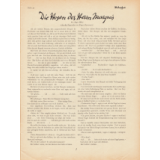
|
Article:
Heltai, Eugen, The Pants of Mr. Marquis (by Eugen Heltai, 1871-1957) (Translated from the Hungarian by Eugen Szatmari [Jenő Szatmári, 1892-1953]).
Issue no. 149, Modenschau.
[Page] 7
|
|
P. 8 |

|
Artikel:
Heltai, Eugen, Die Hosen des Herrn Marquis (aus dem Ungarischen von Eugen Szatmari);
o.V., Kuriositäten-Spiegel.
Mit einer Illustration von Siggel.
|













